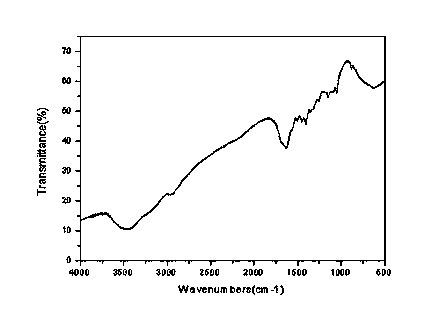Temperature-resistant and salt-resistant copolymer and preparation method thereof
A temperature-resistant, salt-resistant, copolymer technology, applied in the direction of chemical instruments and methods, drilling compositions, etc., can solve the problems that hydrolyzed polyacrylamide is easy to hydrolyze, etc., achieve improved hydrolytic stability, improve hydrolytic stability, and effectively Conducive to the effect of industrial production
- Summary
- Abstract
- Description
- Claims
- Application Information
AI Technical Summary
Problems solved by technology
Method used
Image
Examples
Embodiment 1
[0030] In parts by weight, 69.3 parts of acrylamide and 5.7 parts of N-vinylpyrrolidone are dissolved in 422 parts of water, so that the molar ratio of the two monomers of acrylamide and N, N-dimethylacrylamide is 95:5 , the total mass fraction is 15%; use 2 parts of sodium hydroxide solution to adjust the pH value to 8~10, pour the monomer solution into the reaction vessel, make the temperature of the water bath 5°C, and deoxygenate with nitrogen for 30 minutes; then add 0.003 % Composite initiation system: 0.23 parts of 0.15% potassium persulfate solution, 0.13 parts of 0.09% sodium bisulfite solution, 0.3 parts of 0.6% N,N-dimethylaminoethyl methacrylate; after 30 minutes of reaction, the temperature was raised to 20 DEG C, after continuing the constant temperature polymerization reaction for 4 hours, stop the reaction, add 157.6 g of 5% sodium hydroxide solution to the obtained colloidal product, and hydrolyze it for 1 hour at 80 DEG C, then vacuum-dry and pulverize, namely...
Embodiment 2
[0033] In parts by weight, 85.2 parts of acrylamide and 89.8 parts of N-vinyl caprolactam are dissolved in 293 parts of water, so that the mol ratio of acrylamide and N-vinyl caprolactam two monomers is 65: 35, total The mass fraction is 35%; use 2 parts of sodium hydroxide solution to adjust the pH value to 8~10, pour the monomer solution into the reaction vessel, keep the temperature of the water bath at 15°C, and deoxygenate with nitrogen for 30 minutes; then add 1.5% compound Initiation system: 12.5 parts of 3.15% potassium persulfate solution, 12.5 parts of 15.75% sodium bisulfite solution, 5 parts of 5.25% N,N-dimethylaminoethyl methacrylate; after 120 minutes of reaction, heat up to 50°C After continuing the constant temperature polymerization reaction for 18 hours, stop the reaction, add 71.3 g of sodium hydroxide solution with a concentration of 15% to the obtained colloidal product, and hydrolyze it for 3 hours at 90 ° C, then vacuum dry and pulverize to obtain resist...
Embodiment 3
[0036] In parts by weight, 123.2 parts of acrylamide and 26.8 parts of N-vinyl caprolactam are dissolved in 340 parts of water, so that the mol ratio of acrylamide and N-vinyl caprolactam two monomers is 90: 10, total The mass fraction is 30%; use 2 parts of sodium hydroxide solution to adjust the pH value to 8~10, pour the monomer solution into the reaction vessel, keep the temperature of the water bath at 10°C, and deoxygenate with nitrogen for 30 minutes; then add 0.03% compound initiator System: 5 parts of 0.76% potassium persulfate solution, 1 part of 0.23% sodium bisulfite solution, 1 part of 0.45% N,N-dimethylaminoethyl methacrylate; after 90 minutes of reaction, heat up to 25°C, After continuing the constant temperature polymerization reaction for 12 hours, stop the reaction, add 157.6 g of 10% sodium hydroxide solution to the obtained colloidal product, and hydrolyze it at 90 ° C for 3 hours, then vacuum dry and pulverize to obtain the temperature resistant Salt-resis...
PUM
| Property | Measurement | Unit |
|---|---|---|
| shear viscosity | aaaaa | aaaaa |
Abstract
Description
Claims
Application Information
 Login to View More
Login to View More - R&D
- Intellectual Property
- Life Sciences
- Materials
- Tech Scout
- Unparalleled Data Quality
- Higher Quality Content
- 60% Fewer Hallucinations
Browse by: Latest US Patents, China's latest patents, Technical Efficacy Thesaurus, Application Domain, Technology Topic, Popular Technical Reports.
© 2025 PatSnap. All rights reserved.Legal|Privacy policy|Modern Slavery Act Transparency Statement|Sitemap|About US| Contact US: help@patsnap.com

